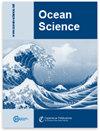Dynamical reconstruction of the upper-ocean state in the central Arctic during the winter period of the MOSAiC expedition
IF 4.1
3区 地球科学
Q2 METEOROLOGY & ATMOSPHERIC SCIENCES
引用次数: 0
Abstract
Abstract. This paper presents a methodological tool for dynamic reconstruction of the state of the ocean, based, as an example, on observations from the Multidisciplinary drifting Observatory for the Study of Arctic Climate (MOSAiC) experiment. The data used in this study were collected in the Amundsen Basin between October 2019 and January 2020. Analysing observational data to assess tracer field and upper-ocean dynamics is highly challenging when measurement platforms drift with the ice pack due to continuous drift speed and direction changes. We have equipped the new version of the coastal branch of the global Finite-volumE sea ice–Ocean Model (FESOM-C) with a nudging method. Model nudging was carried out assuming a quasi-steady state. Overall, the model can reproduce the lateral and vertical structure of the temperature, salinity, and density fields, which allows for projecting dynamically consistent features of these fields onto a regular grid. We identify two separate depth ranges of enhanced eddy kinetic energy located around two maxima in buoyancy frequency: the depth of the upper halocline and the depth of the warm (modified) Atlantic Water. Simulations reveal a notable decrease in surface layer salinity and density in the Amundsen Basin towards the north but no significant gradient from east to west. However, we find a mixed-layer deepening from east to west, with a 0.084 m km−1 gradient at 0.6 m km−1 standard deviation, compared to a weak deepening from south to north. The model resolves several stationary eddies in the warm Atlantic Water and provides insights into the associated dynamics. The model output can be used to further analyse the thermohaline structure and related dynamics associated with mesoscale and submesoscale processes in the central Arctic, such as estimates of heat fluxes or mass transport. The developed nudging method can be utilized to incorporate observational data from a diverse set of instruments and for further analysis of data from the MOSAiC expedition.MOSAiC 考察冬季期间北极中部上层海洋状态的动力学重建
摘要本文以北极气候研究多学科漂流观测站(MOSAiC)实验的观测数据为例,介绍了一种动态重建海洋状态的方法工具。本研究使用的数据是 2019 年 10 月至 2020 年 1 月期间在阿蒙森盆地收集的。由于漂移速度和方向不断变化,当测量平台随冰盖漂移时,分析观测数据以评估示踪剂场和上层海洋动态具有很大的挑战性。我们在新版全球有限体积海冰-海洋模式(FESOM-C)沿岸分支中采用了推移方法。模型推移是在准稳定状态下进行的。总体而言,该模式可以再现温度场、盐度场和密度场的横向和纵向结构,从而可以将这些场的动态特征投影到规则网格上。我们在浮力频率的两个最大值附近发现了两个独立的涡旋动能增强的深度范围:上卤跃层深度和大西洋暖(改良)水深度。模拟结果显示,阿蒙森海盆表层盐度和密度向北明显下降,但从东到西没有明显梯度。然而,我们发现混合层自东向西逐渐加深,梯度为 0.084 米/公里-1,标准偏差为 0.6 米/公里-1,而自南向北的加深程度较弱。该模式解析了大西洋暖流中的几个静止漩涡,并提供了相关动力学的见解。该模式的输出结果可用于进一步分析与北极中部中尺度和亚中尺度过程相关的热盐结构和相关动力学,例如热通量或质量输运的估算。开发的推导方法可用于纳入来自各种仪器的观测数据,并用于进一步分析 MOSAiC 远征的数据。
本文章由计算机程序翻译,如有差异,请以英文原文为准。
求助全文
约1分钟内获得全文
求助全文
来源期刊

Ocean Science
地学-海洋学
CiteScore
5.90
自引率
6.20%
发文量
78
审稿时长
6-12 weeks
期刊介绍:
Ocean Science (OS) is a not-for-profit international open-access scientific journal dedicated to the publication and discussion of research articles, short communications, and review papers on all aspects of ocean science: experimental, theoretical, and laboratory. The primary objective is to publish a very high-quality scientific journal with free Internet-based access for researchers and other interested people throughout the world.
Electronic submission of articles is used to keep publication costs to a minimum. The costs will be covered by a moderate per-page charge paid by the authors. The peer-review process also makes use of the Internet. It includes an 8-week online discussion period with the original submitted manuscript and all comments. If accepted, the final revised paper will be published online.
Ocean Science covers the following fields: ocean physics (i.e. ocean structure, circulation, tides, and internal waves); ocean chemistry; biological oceanography; air–sea interactions; ocean models – physical, chemical, biological, and biochemical; coastal and shelf edge processes; paleooceanography.
 求助内容:
求助内容: 应助结果提醒方式:
应助结果提醒方式:


